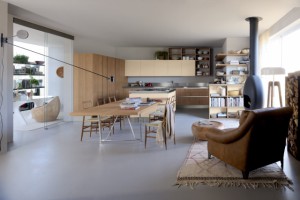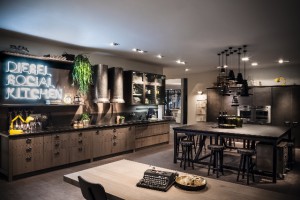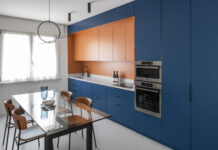Food and design are two worlds that find a perfect union in the kitchen and if we speak of Italian kitchen the ‘wedding’ becomes a point of reference all over the world. Today more than ever, since this made-in-Italy furniture field expresses a very high, sartorial and flexible quality, even when we are speaking about big size industries.

by Raffaella Razzano, Ambiente Cucina Magazine
The new stylistic and compositional trends are all born in our country and tell of a kitchen space more and more open to the living area, whose conviviality is enhanced by the naturalness of the wood, present in a contemporary way but also perfect for interpreting a widespread vintage style that ranges from the most extreme industrial to the Fifties mentions. Stylistic trends have still left, however, room for that minimalism which has been the Italian language for excellence over the years, and still nowadays speaks about us across the world. The absence of handles, the choice of mono material interpreted by the new composite materials, more and more lasting and easy to work with, mechanisms or cupboards that make appear, and disappear, all technical areas are the signs of a clean design that remains but which today draws less monumental and more cozy solutions.
The connections with the living
The need to connect the kitchen with the living room, a trend confirmed also by the architecture of the new homes, has generated new compositions, leaving much room to the islands with staggered levels, that simultaneously lend themselves to the preparation and enjoyment of meals. A ritual that becomes fast with the snacks plans, some folding to save space, or slow thanks to massive tables that intersect with more technical areas. The proposal is enriched with shelves, bookcases, storage modules in evidence and showcases to create connecting walls or interrupt the traditional continuity of base modules and wall units.
Super items
In this regard, the arrival in the sector of some famous designers in 2014, who for the first time have ventured into the kitchen, has produced extraordinary and totally out scheme results, that have overcome the concept of standard module in favor of “items” of great scenic impact or, anyhow, of solutions with self-supporting blocks. We are talking in particular about Patricia Urquiola, who has designed Salinas for Boffi, and of Carlo Cappai and Alessandra Segantini of C+S study, which have conceived for Elmar the new @home dimension, articulated by scenic but absolutely functional elements, such as the organ hood or the big wooden table with steel hob integrated. The hallmark of Nendo too, which has proposed Ki for Scavolini, lives through a single container, a strictly white basin, which becomes time to time hanging cupboard, hob, sink and even sitting. All with the maximum flexibility and also concreteness.
Wish for what is ‘lived’
Working with blocks is also a tribute to the kitchen of the memory, but the recent one, which was divided into a few pieces: the cupboard, now proposed again by many companies, the economic stove, nowadays converted in the major and free standing kitchen block, the first Fifties refrigerators returning with great emphasis. Indisputable signs of a love for lived kitchen, where you can breathe sometimes even the atmosphere of industrial archeology. A flavor that was proposed for the first time by Scavolini “Social Kitchen” for Diesel, and that can be found today in the projects of many companies, invoked explicitly in some cases in the names of the kitchens themselves as Sand Industrial Edition proposed by Febal and Industrial Chic designed by L’Ottocento. In this case, the scene is dominated more than ever by scratched and aged woods, but also by metals such as sheet metal, pewter and copper, also burnished and treated.

Tech Wood
Wood again, but much more rigorous, both for the daring combinations with other materials, primarily steel, and for the formal interpretation that honors the most authentic spirit of minimalism that removes to get to the essence of things. Master of harmony Piero Lissoni, Boffi art director, proposes, for example, the Open kitchen, made of steel and born for the outside, but also able to live indoors and to find a brave combination with the rough wooden cupboard. Approached to the stone work surface and to the metal of the supporting structure, the wood defines Beluga, refined project by Ferruccio Laviani, that definitively consecrates the debut of the new brand Rastelli, born from the expertise of Aran.
Super technological Soul, signed by Giuseppe Bavuso for Ernestomeda, finds a new stylish dimension through the encounter between some wood details and the exclusive treatment with nanotechnology of the lacquered elements used for the fronts. Rich of patents as the previous Icon, by Bavuso too, Soul convinces even more thanks to its warmth. It is probably one of the most accomplished expressions of the research and of the typical Italian innovation ability.
Renaissance luxury
Speaking about know-how, to conclude, it is fair to mention the cabinetmaker skill of who is still able to chisel, carve, decorate the raw material to produce dream kitchens. Signs of a luxury that fascinates and conquers the international audience and reminds our renaissance culture to the world.



